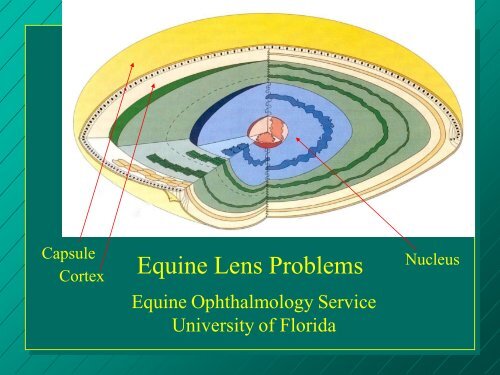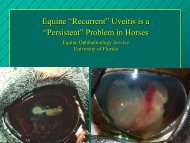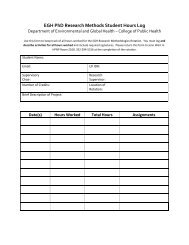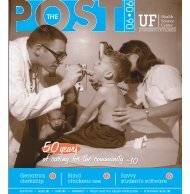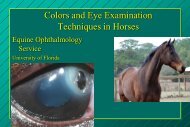Equine Lens Problems - University of Florida
Equine Lens Problems - University of Florida
Equine Lens Problems - University of Florida
- No tags were found...
You also want an ePaper? Increase the reach of your titles
YUMPU automatically turns print PDFs into web optimized ePapers that Google loves.
•The lens sits in thepatellar fossa <strong>of</strong> thevitreous.•The horse has weak accommodation (< 2.0 D) to maintain afocussed retinal image.
21/4/2009Cigoto – Segmentación - Blastulación –Gástrulación – OrganogénesisImagen real de una blástula4
ERU cataract/synechia
Matt Stevens
• Multifocal lens with horizontal pupil• Zones <strong>of</strong> optical discontinuity
Nuclear cataract
Immature cataract
Morgan horse hereditary nuclear cataract
Whip injury
Therapy for Uveitic Cataracts• Medical: Oral aspirin might delay cataractformation in a few ERU horses• 10 mg/kg q24h• Surgery: Only chance for vision– Not easy– Client must be educated about the risks andbenefits, and must have realistic expectations!
• healthy foals(Rhodococcus free) andadult horses• no uveitis• visual impairment• the personality to toleratetopical therapy• Brisk PLRs and a dazzleindicate a functionalretina.• US (RDs)• ERG (esp Appaloosas)Cataract PatientCriteria
• ERG: Dark adapt 20minutes
ERG
Light Stimulus
US: mature cataract
US: posterior lens capsule rupture
RD: “seagull” sign
<strong>Lens</strong> fragments lying on retina.
“Phaco”
Phaco Surgical Procedure• Paralysis with atracurium• Scleral tunnel w/cautery• CCC• Standard SA needle; 15 mm• Horse needle is 23 mm• Machines• Hylartin-V viscoelastic• Mean phaco time: 10:05minutes (range 4:32 – 15:49)
Medications Postoperatively• Sulfas systemically for 5 days• Banamine (+/- omeprazole): several weeks• Topical Atropine: 2 weeks• Topical antibiotics: 2 weeks• Topical Prednisolone acetate: 1-3 months• Hospital stay: avg 8 days, range 3-15 days
Phacoemulsification.• Success rate ~ 83-98%initially in horses.– Declines rapidly with timedue to capsuler scarringand persistent uveitis– 49% at one month (OSU)– 44% at one year (TAMU)– 39% at 18 months (UF)• Surgery is easiest in foalsand yearlings.
• Complications: corneal ulcers, persistent corneal edemaand ulcers, glaucoma, hyphema, and infectiousendophthalmitis– Vision is functional but the aphakic horse should be hyperopic“far-sighted”• The aphakic equine globe is +9.9 D hyperopic (20/1200).– A 25 D IOL = +8.0 D
IOL
Intraocular <strong>Lens</strong>es (IOLs) in Horses
Knotty06
<strong>Lens</strong> Luxation in HorsesAnterior lens luxation
Aphakic crescentTrauma from cross ties
<strong>Lens</strong> subluxation4 wks later
<strong>Lens</strong> Cysts


